Corsair are the makers of some of the most well-known and best selling keyboards in the world of gaming, and especially their top of the line full size flagship keyboards seem to be particularly popular. Today we’re taking a look at their newest flagship offering: the K100 RGB.
Corsair have really gone all out here: they’ve included a brand new switch, added a multifunctional dial, gone for PBT keycaps, slapped in an improved wrist rest, and the whole thing is powered by Corsair’s AXON Hyper-Processing tech, giving the board a polling rate of 4000Hz as well as massive amounts of onboard storage.
That all sounds really impressive, so we sent one over to our reviewer to see what he thinks of it. Read our full review to find out!
At A Glance
Corsair K100 RGB
Used by 1 player ()The Corsair K100 RGB is a very ambitious board by Corsair. They’ve got a bunch of new tech and new features in here and for the most part all of this hits the spot.
Pros
- Lots of extra dials and features for the full ‘battlestation’ experience
- PBT keycaps feel good
- Included padded wrist rest
- Fast OPX switches are good for gaming
- Extra row of macro keys
Cons
- Expensive
- Not very portable
- Macro keys might take some getting used to for some
Specs
| Form Factor | Full Size |
|---|---|
| Switches | Corsair OPX, Cherry MX Speed |
| PCB | Non-Hotswappable |
| RGB | Yes |
| Height | 4.6cm |
| Width | 47.0cm |
| Length | 16.5cm |
| Weight | 1300g |
First Impressions
This isn’t the first full size ‘battle station style’ keyboard from Corsair I’ve had on my desk but I still was a bit blown away by how big and heavy this thing is. This is definitely not the one to go for if you want a board with a minimal footprint. Of course people who are interested in this board will know that and don’t mind the large form factor but since this section is about first impressions I couldn’t exactly leave this part out.
Something else that I noticed is that the wrist rest has undergone some changes. Corsair have pretty much always included a wrist rest with their premium offerings and as someone who usually doesn’t use these I can’t say that I’m an expert but this one is without a doubt a massive improvement over what they offered in the past, though more on that later on in the review.
One final thing to note are the changes to the keycaps. These are PBT (nice) and the font has been changed to a slightly more subtle looking one. I don’t much care about fonts on keyboards since I usually swap out the keycaps on my main boards anyway and I can’t say that I had a big problem with what Corsair was using in the past but I do know that a lot of people weren’t fans of the font so it’s nice to see that Corsair has listened. Speaking of listening: the bottom row is now standard, so if you still have a problem with the font you can swap out these caps without having to look for obscure sizes.
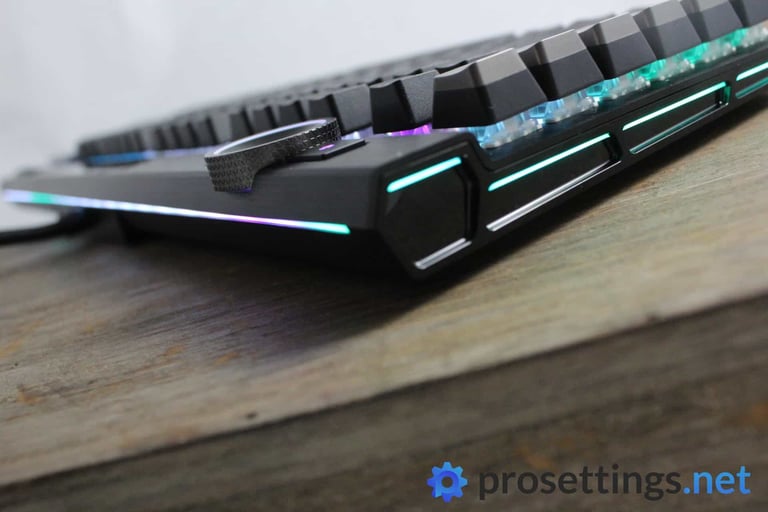
I also want to say that I really like the way Corsair’s flagship boards look, and that’s no different here. While I would personally never use a full size board as my main keyboard (I find them too big) this is without a doubt a keyboard you shouldn’t be ashamed of. The brushed aluminum top gives it a sleek and premium look, and the underglow RGB elements that can be found at the sides and back of the board really do help it pop. The whole thing is finished off by the glass panel at the top that houses the logo (just the sails this time, the ‘CORSAIR’ isn’t there anymore) and indicators. That panel is a bit of a fingerprint magnet but I really don’t see why you’d even have your fingers there once the board is on your desk so that’s a non-issue for me.
As with other Corsair boards the housing here is made out of plastic with a brushed aluminum top. This results in a sturdy and reliable keyboard that should be able to take a beating or two. The cable is sturdy as well, to say the least. This thick, non-detachable cable is of the ‘bridge suspender’ variety. That’s not a problem for these full-featured types of keyboard (though I would be a bit miffed to see a cable like this on a ‘tournament style’ compact board) but it is something to be aware of in case you’re thinking of hitting the road often.
Corsair have long been known as a company that’s playing in the top leagues when it comes to RGB, and this K100 is another shiny jewel to add to that crown. The default lighting is nice enough on its own: the aluminum plate is a tiny bit reflective, giving the RGB elements a kind of ethereal extra touch, but the lighting elements on the side put the cherry on top for me. Covering the entire back and both sides of the K100, these multi zone RGB strips really make the board stand out, and if you’re someone who’s into RGB lighting you will absolutely love this one.
Packaging
Corsair are known to provide extras with their top keyboards and they luckily haven’t stopped doing that here. Inside the box you get the wrist rest, along with the usual documentation, a keycap puller, and two sets of extra textured and formed keycaps: one set for FPS gaming and another for MOBAs.
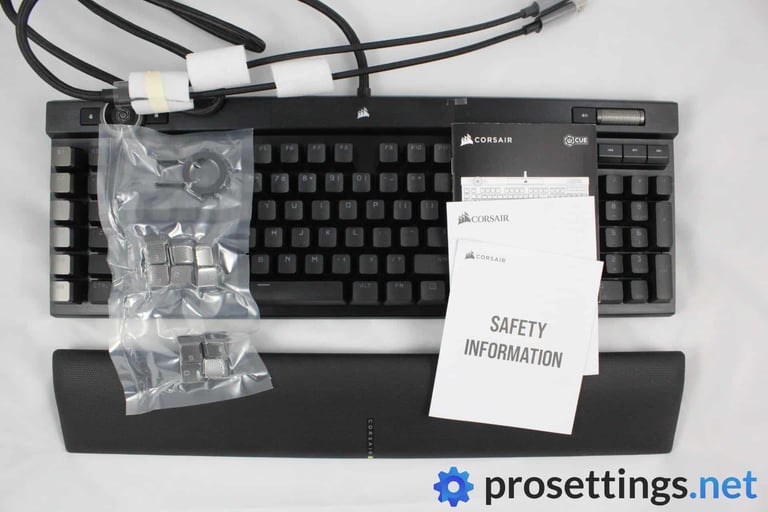
One thing to note is that these extra caps aren’t the same as the thicker and more premium caps that are on the board by default. That’s not a deal breaker though: they have a different texturing on the top so you’re not likely to be annoyed by them feeling very different since that’s sort of the point. Still, though, this board is selling at a premium price (for mass-produced boards, that is: I know custom mechs run much, much dearer) so I would’ve liked to see the extra caps being on par with the others, even though I’m nitpicking.
You do get everything you need in the box, and I always love it when keyboard companies include a cap puller so well done Corsair.
Features and Build
This K100 is very much a ‘throw everything we’ve got at it‘ type of product so there’s a lot to unpack here. Those who are familiar with Corsair’s full size offerings will recognize the media keys as well as the volume wheel on the right side. These have now been joined by a multi functional dial on the left side. This control dial takes up a prominent spot in their marketing but I am not super impressed by it.
This particular wheel can be used to tweak the brightness of the RGB, scroll horizontally, zoom, and so on, so in theory it’s a cool addition but the problem is that whatever function it’s in is indicated by a color. If you’ve got a lot of functions activated it can take you quite a bit of time to get over that ‘I wanted to scroll but accidentally skipped the song I was listening to‘ phase. I think a notification on your monitor to tell you what mode you’ve just switched to or perhaps even a tiny screen on the board itself to let you know what you’re doing would elevate this whole concept a bit.
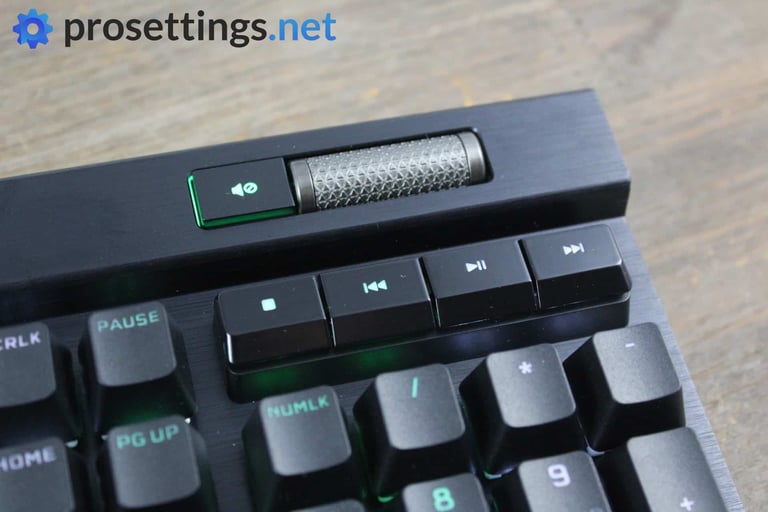
All extra wheels and rockers feel nice to use, however. The control wheel is made out of aluminum and has slightly defined steps to it while the volume wheel on the upper right side of the board is smooth. The media buttons underneath that volume control don’t sound very clicky but there’s enough feedback to let you know when you’ve pressed them. The buttons to select a profile, lock the windows keys, and mute the board do have a very clicky feeling to them though so for uniformity’s sake I would’ve preferred all of these buttons to feel the same but I am aware of the fact that this is extremely nitpicky.
The wrist rest, then, is honestly amazing. I usually test these out for a couple of hours and then throw them in the box and forget about them but this one clicked for me. This is a soft wrist rest that (for me) is just about the perfect height and at a great angle so I left it on for the duration of my entire testing period. It connects to the board via a magnetic system so attaching and detaching it is easy as can be. Compared to what Corsair offered on earlier boards this is an immense upgrade and the only bad thing I have to say about it is that the placement of their logo annoys me a bit.
In the middle of the wrist rest they printed ‘CORSAIR’ followed by a yellow square. That square caused me to think there was a crumb or something else on my desk multiple times when I saw it in my peripheral vision. I know that that’s my own dumb fault but I can’t help but feel like the whole thing would look a bit cleaner without the printed name + square on the bottom regardless.
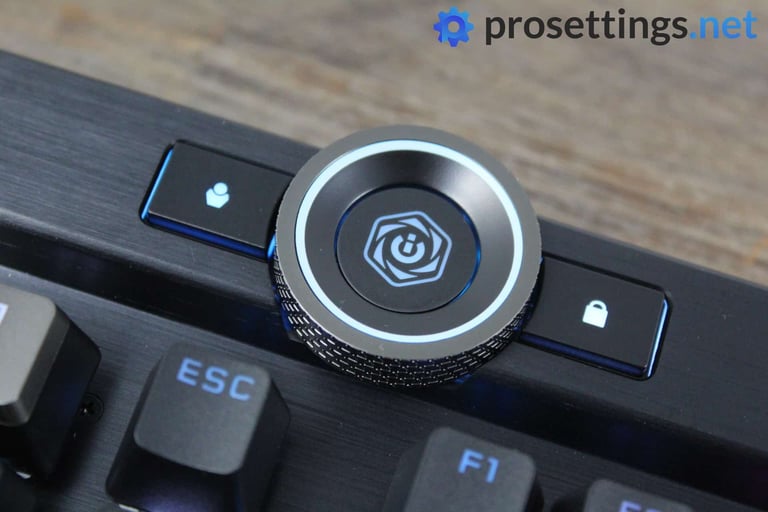
On the back of the board you’ve got one USB passthrough port and on the bottom there are four large rubber feet as well as extendable feet that allow you to put the board at two different angles in case you don’t like it to lay flat. There are also cable routing channels so that you can rout your other cables (these channels aren’t meant for the keyboard cable) underneath the board.
On the left there’s a row of six dedicated macro buttons that you can program to do pretty much anything you can dream of (more on Corsair’s software later) and can be fully integrated with Elgato Stream Deck in case you’ve got that running. One small thing to note is that these macro keys don’t feature PBT keycaps but other than that they’re fine. I don’t find myself using these for anything ingame but if you’re someone who does like these things you’ll find that they are well positioned and are easy to hit in the heat of battle.
One of the most talked about features of the K100 isn’t visible to the naked eye: the AXON Hyper-Processing Technology allows this keyboard to operate at 4000Hz. That’s precisely four times as fast as other keyboards but that’s not all. You can save up to 200 (depending on the complexity) different profiles on the keyboard itself. That’s impressive, and even though the 4000Hz polling rate might not be as impactful as you’d think (more on that in the next section) it’s definitely nice to see that Corsair is pushing the boundaries here.
In short: Corsair has gone all out here and crammed a lot of features into this board. Not all of them hit the bullseye and could use some refining here and there but none of the extra knobs, dials, and features are annoying or feel as if they’re a complete afterthought so that’s nice to see.
Performance and Everyday Usage
The K100 is the first board to feature Corsair’s OPX optical-mechanical keyswitches. Other gaming keyboard manufacturers have been going in this direction for a while so it’s only natural that a keyboard behemoth such as Corsair couldn’t stay behind for too long. In case you’re interested in the specs: these OPX switches require 45G of force to actuate, which they do at 1.0 mm. Combine that with a total travel of 3.2 mm and you’ve got yourself some speedy switches. Not only are they among the fastest feeling switches out there, they’re also extremely durable. These are rated at 150 million key presses. That’s a lot of games.
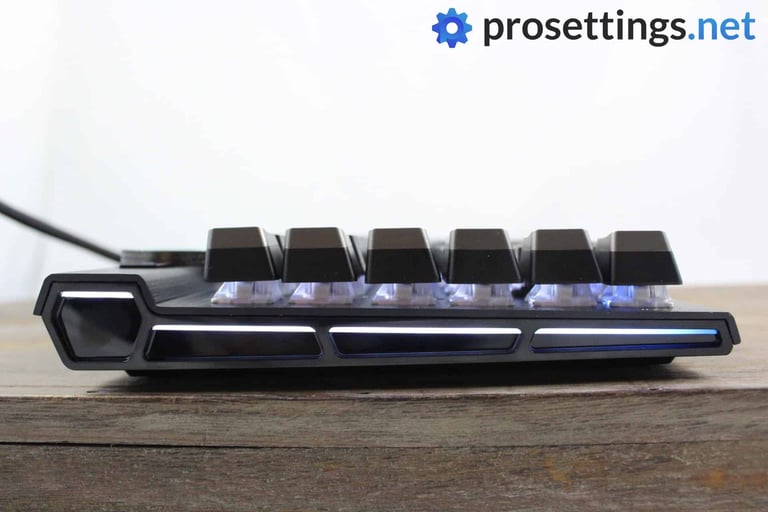
Of course specs can be as impressive as they want, but what really matters is how these things feel. The switches are marketed as hyper-fast and I can attest to the fact that they really are. If you’re not used to this type of switch (a good comparison would be the Cherry MX or Kailh Speed Silvers) you will want to take a bit of time getting used to it before hopping into a serious competitive match because you will encounter some accidental key presses. I’m not someone who thinks that one certain switch can objectively be the best gaming switch out there, as a lot of this comes down to what you prefer, but if you’ve got that need for speed these will no doubt suit you well.
The performance is pretty impressive but I am not a real fan of how this board sounds. I am a pretty heavy typist so your experience may vary but some keys sound a bit hollow and ‘resonating’ so to say, as if there’s not enough material inside the case. I tried to bring this across in the sound clip to the right but it’s kind of hard to record it with the mics that I have at my disposal. In any case: this kind of hollow and pretty loud acoustic experience isn’t something that I’m partial to and that combined with the ‘dink’ sound that some keys exhibit turns me off a bit, but again: your experience may vary. These things can be subjective.
As far as the larger keys and stabilizers go I can say that Corsair has done a good job. This historically hasn’t always been the case but they seem to be upping their game. There’s still a bit of rattling and wobbling on some keys but overall this is definitely a step in the right direction.
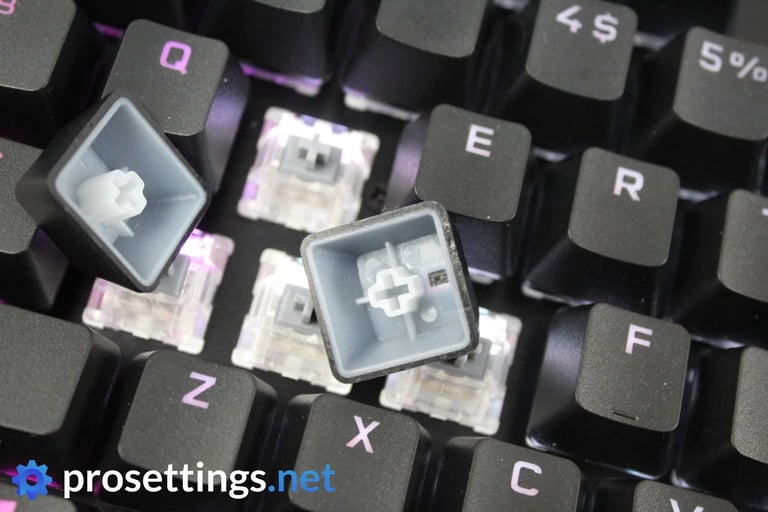
On to the 4000Hz polling rate then. Let me start off by saying that you have to activate this in Corsair’s iCUE software first, so don’t hop into a game immediately if you want to try it out. I played a number of games (VALORANT, CS:GO, some single player games) with the board at 4000Hz and I honestly can’t say that I noticed a huge difference. That doesn’t mean that I don’t applaud the fact that they’ve got this tech in the board, but if you’re expecting to shoot up the ranks due to the report rate of this board you will probably want to lower your expectations.
In case you’re absolutely not a fan of driver programs you can do pretty much everything you want with the K100 (including programming macros) on the board itself but for all others there’s Corsair’s iCUE. This (to me) has never been the easiest to use piece of peripheral software on the market but once you get over the learning curve the possibilities are nearly endless. You can program macros, adjust the lighting, customize what the wheel does, and so on and so forth. I don’t think anyone who wants to have the full array of options at their disposal will ever be disappointed by what Corsair offers.
All in all this is a great gaming board. The switches are super fast, and while the sound isn’t for me I can definitely say that I enjoyed my time testing this board in a variety of games. If you’re looking for a lightning fast linear switch this might be it, and while the 4000Hz polling rate isn’t something that’s immediately noticeable to me it’s good to see that the company is willing to make changes and push the boundaries.
Sound Test
Corsair K100 RGB Review – Conclusion
The Corsair K100 RGB is a very ambitious board by Corsair. They’ve got a bunch of new tech and new features in here and for the most part all of this hits the spot. The switches feel extremely fast, and while I am not a fan of the sound of this board I have to say that it feels and performs great in games. The 4000Hz report rate isn’t something that I particularly noticed when gaming, but I am never going to speak badly of companies that try to push the limit of existing tech so it’s cool to see that Corsair is doing just that. Gaming panels and GPUs are becoming faster and faster, so Corsair keeping up with that trend probably isn’t for naught.
If you’re after a ‘battlestation style’ mechanical keyboard with fast linear switches and just about all of the extra features you could ever want then this is a hard one to look past. Sure, it comes at a premium price point, but not a lot of full sized keyboards offer what this one does. You get dedicated media controls, a multifunctional dial (which could be tweaked a bit to be more user friendly in all honesty), super fast switches, PBT keycaps, dedicated macro keys, great RGB lighting, a fantastic wrist rest, and all of that is packed into a sleek looking board.
It’s not without its faults but the K100 comes recommended if you’re looking to get the latest and greatest full sized board for your gaming sessions.
This product was received for free from the manufacturer and given to our reviewer to test and review. Brands and manufacturers have no editorial control over our reviews. For more information, check out our review FAQ.


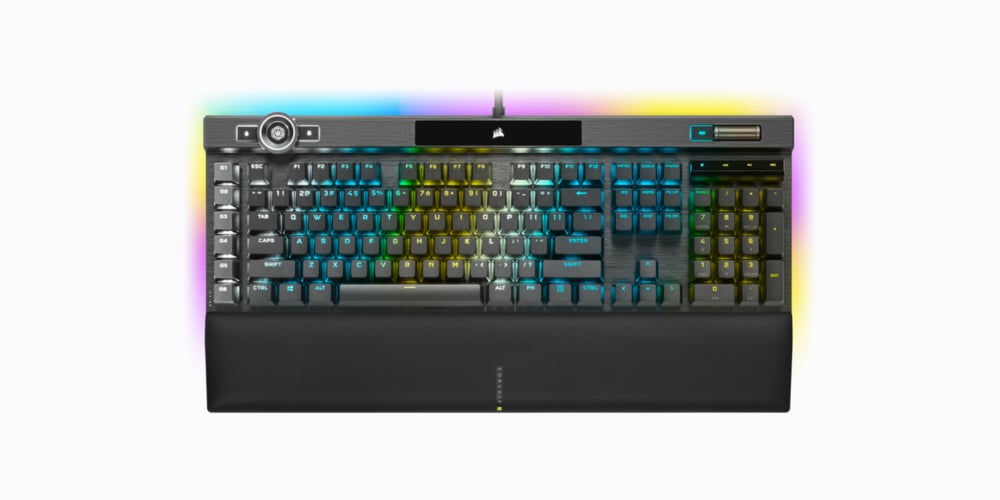


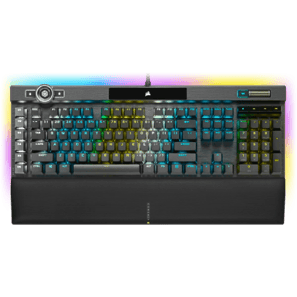


Thanks for the nice review.
One question is, which do you think is better, the Corsair K100 or the SteelSeries Apex Pro?
I’m wondering whether to buy K100, Apex Pro or G915.
I would like to hear your personal opinion.
I’m Japanese and this English is translated by Google.
Please forgive me for the wrong use of English.
Hi,
No worries, I understand everything! Out of those I think the K100 and the Apex Pro are a league above the G915. It kind of depends on the features that you would like I would say. For me, the K100 is just a bit large and unwieldy so I would go for the Apex Pro but if you want that kind of ‘space station style’ keyboard then the K100 is a fantastic choice. I would go for the Apex Pro though (I like the typing experience a bit better) but if these kinds of boards are what you’re after then you can’t really go wrong with either one.